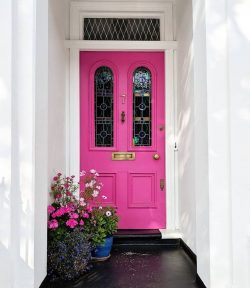Ways To Choose The Best Outdoor Paint For Your Home
November 11, 2021
How to choose the best outdoor paint for your home
Anyone who’s been to a paint store knows that house paint comes in a seemingly endless variety of colors and textures. And to make matters worse, many brands market products specifically for internal use, external use or even both. All this makes settling on the right outdoor paint for your home a challenge.
That said, a little research plus a few handy rules of thumb will make the process much more manageable. So whether you’d like to refresh your front door, some window sills or tackle it all, this guide to exterior paint is for you.
Latex- or oil-based?
One big decision when shopping for external paint is which formulation to choose.  There are two basic types of house paint: latex-based and oil-based. Oil-based (aka alkyd) paint has been in use the longest and was once heavily favored by professional painters. It dries hard, it’s water resistant and it’s highly durable.
There are two basic types of house paint: latex-based and oil-based. Oil-based (aka alkyd) paint has been in use the longest and was once heavily favored by professional painters. It dries hard, it’s water resistant and it’s highly durable.
There’s a big drawback with oil-based paint though. It’s tricky to clean up after. Since it isn’t water soluble, you need to clean painting tools with chemical solvents such as mineral oil.
On the other hand, cleaning tools after using latex-based paints is a lot less of a hassle. All you need is water.
Additionally, modern latex coatings have come a long way. Today’s acrylic latex paint formulas are much more durable than they used to be.
In fact, many are tough enough to use on common exterior materials. These include wood, brick, vinyl siding, doors and trim.
And an anecdotal chat with a local house-painting pro in my neck of the woods echoed these developments. The professional painter I spoke to told me that he doesn’t use oil-based paint anymore. When I asked why, he said, “They’re too much of a pain to deal with.”
He went on to stress that I shouldn’t put much stock into people who believe oil-based paints are the best you can get. He personally vouches for Sherwin-Williams Duration Exterior Acrylic Latex. It’s his exterior paint of choice. He also told me that another solid option is PPG Permanizer Exterior Acrylic Latex.
Color
This is the most subjective choice you’ll have to make. The exact hue of outdoor paint you ultimately decide to use is a deeply personal calculation. That said, some of your considerations may depend on the style of your house.
For instance, I feel a midcentury-style ranch house looks best with a front door painted in an eye-popping pastel teal or orange.
That’s especially true if the rest of the structure consists of relatively tame beige brick.
 Likewise, a more traditional colonial-style house might benefit from a subdued green, gray or even black.
Likewise, a more traditional colonial-style house might benefit from a subdued green, gray or even black.
The window shutters often found on these houses are a good candidate for these color treatments.
It’s a good way to offset the traditionally brighter exterior walls of colonial homes. You may feel the urge to go against convention — just keep in mind that too much of a departure may clash negatively with houses nearby.
Last, select your finish
Once you’ve zeroed in on the color and type of paint, it’s time to choose the finish. Most paints are available in a variety of finishes (aka sheen). They typically range from flat, which has a matte, nonreflective finish to high-gloss.
As you’d expect, high-gloss paint has the most shine when it dries. One step below that is semigloss, which reflects less light.
A satin finish returns still less light, while eggshell is slightly more reflective than flat.
Highly reflective finishes are good for drawing the eye. That’s why they’re a good choice for trimming, front doors and windows.
Low-gloss paint is typically used for the main body of a house. That’s because a matte finish tends to conceal surface imperfections well.
Skyway Home Improvement is a construction company located in New Jersey. We are fast and our goal is to provide a service that exceeds clients’ expectation. Contact us on Facebook.
